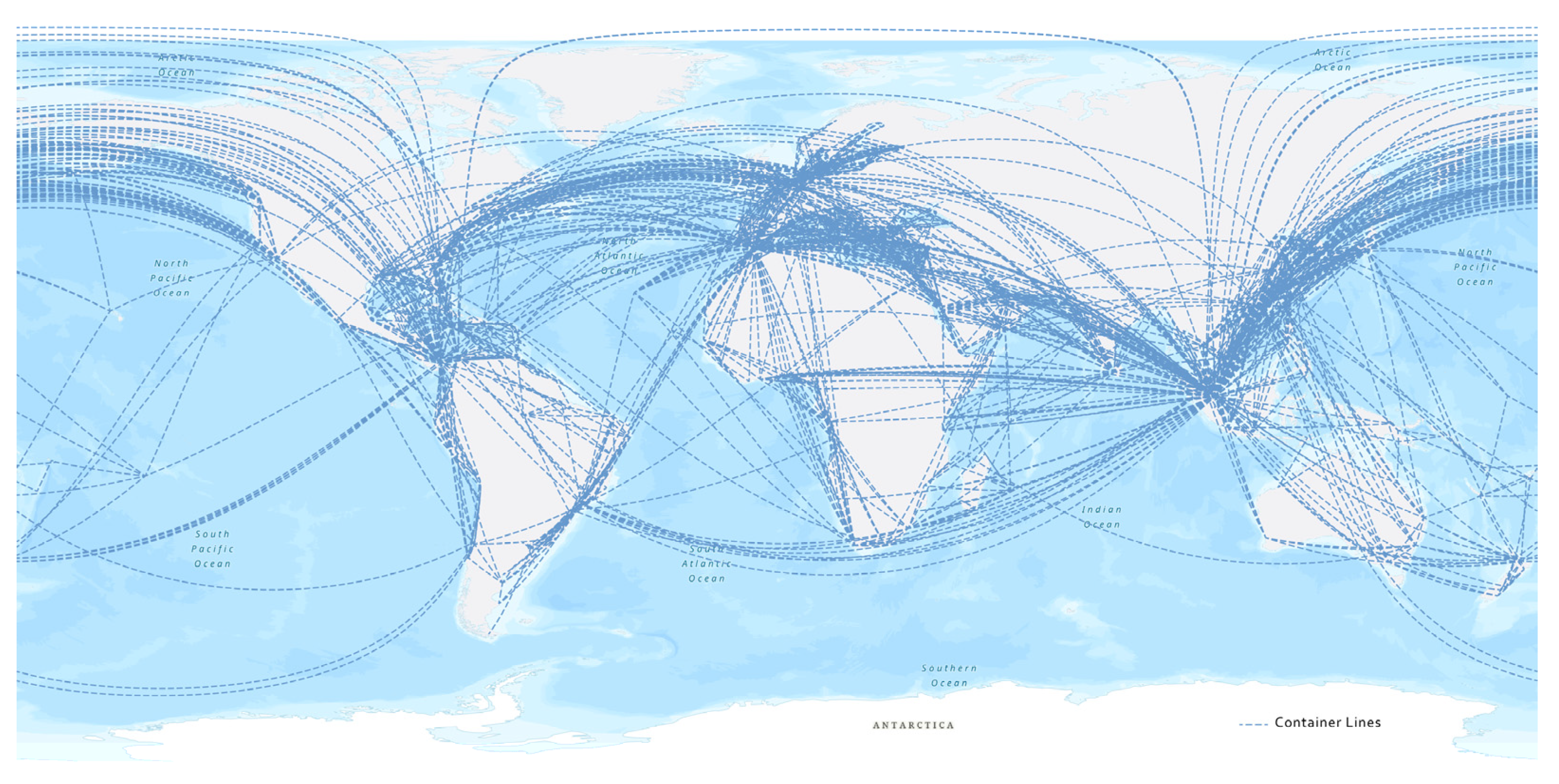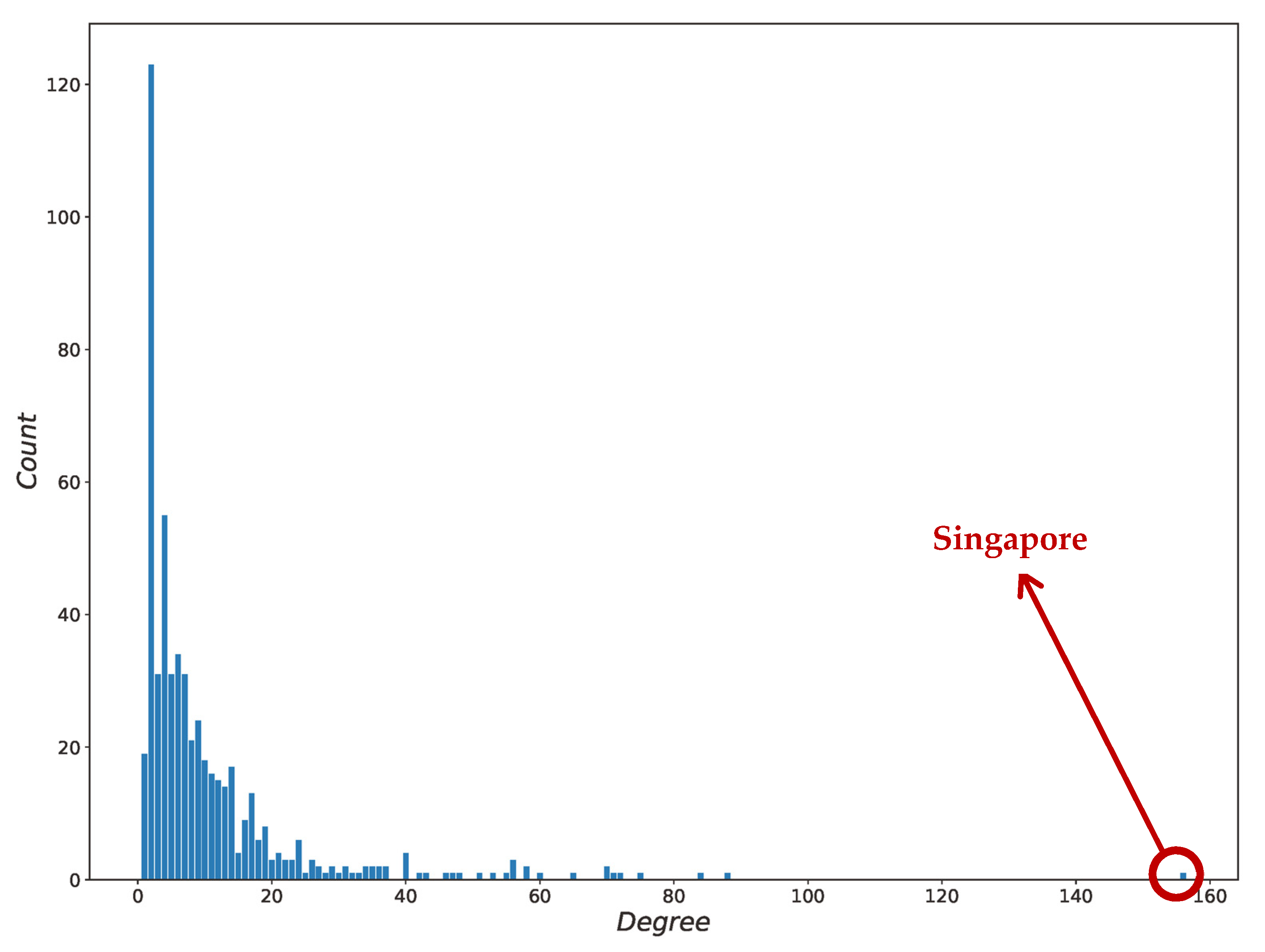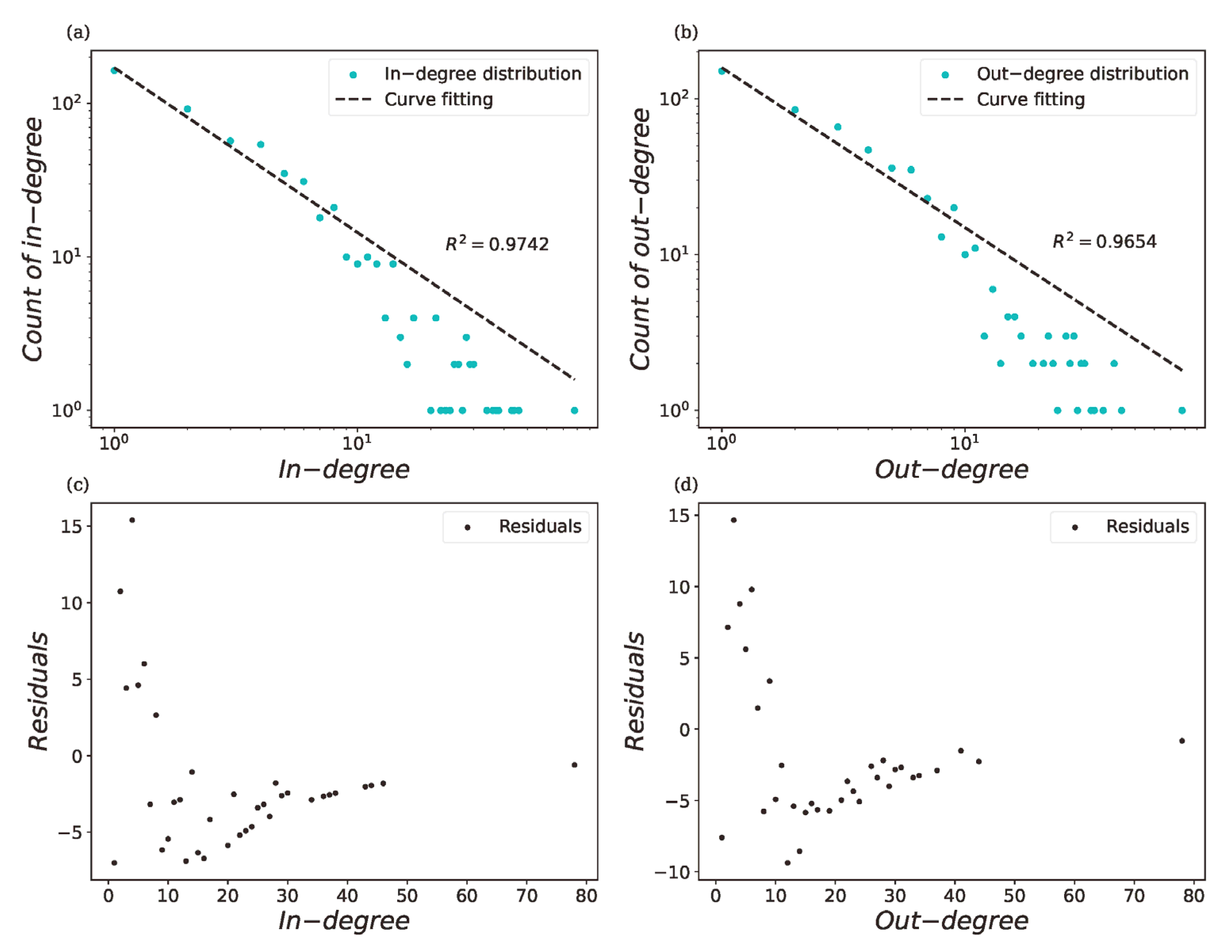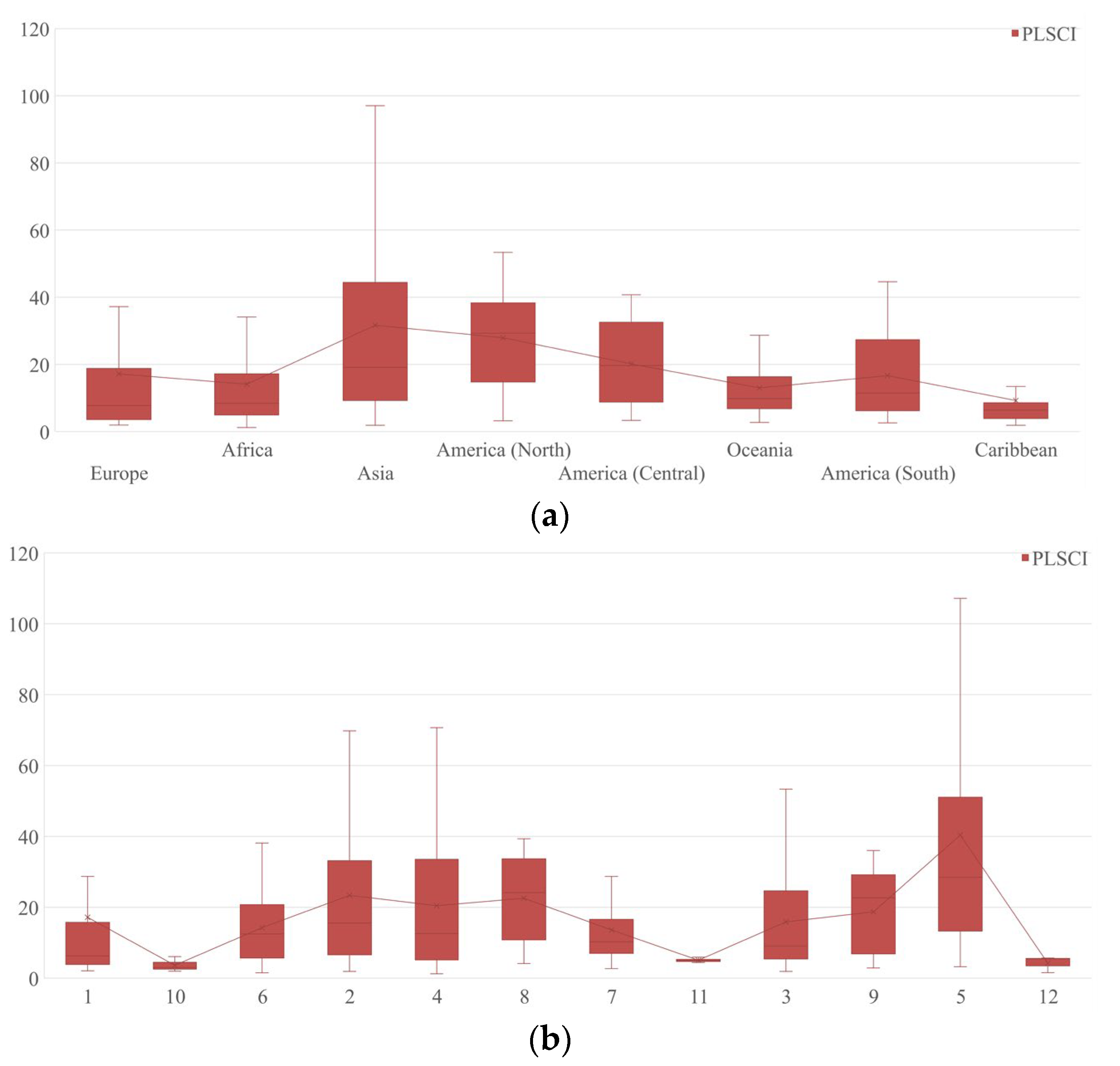1. Introduction
Over 80% of international trade volume, accounting for 70% of its trade value, is carried by ships and handled by seaports around the world [
1]. Maritime transport is regarded as the backbone of global trade and the lifeblood of the global economy. The operational performance of ports and the links between ports together form the maritime transport network, which has an important influence on global maritime trade [
2]. Thus, research on maritime transport networks as well as port connectivity and accessibility has received increasing attention in recent years [
3,
4].
Traditional shipping studies relied upon indicators such as the GDP or freight index to analyze trade volume and the value between countries [
5,
6,
7]. In 2004, the United Nations Conference on Trade and Development (UNCTAD) proposed the Liner Shipping Connectivity Index (LSCI) for shipping connectivity [
8] and later extended the LSCI to the Port-LSCI (PLSCI) in 2019 to quantify the efficiency of a port for handling ships and cargo. Many researchers have, therefore, started to use the PLSCI for port competitiveness assessments. For example, Tovar and Wall [
9] used the PLSCI to analyze the relationship between port connectivity and port productivity, and conducted case studies in 16 Spanish ports. Their results illustrated a strong positive correlation between the connectivity and efficiency of ports. In addition to the PLSCI, researchers have developed a variety of port performance indicators [
10]. However, these indicators tend to focus on the capabilities of ports themselves with little regard for the global characteristics and the directionality of shipping networks, which are important to maritime transport.
With the development of network science, the quantitative analysis of the topological characteristics of liner shipping networks (LSNs), globally or within a specific area, is a relatively new research topic [
11,
12]. Space-L and Space-P theories are used to represent the topology of complex maritime transport networks [
13]. In Space-L, a link is created between consecutive stops in one route; in Space-P, all ports that belong to the same route are connected. Both methods have been adopted in shipping network research [
14,
15]. As routes from/to a port are often different, a directed LSN using Space-L reflects the practical situation more faithfully [
16,
17,
18,
19].
The rapid increase in world trade and maritime transportation has increased competition among ports. The performance of ports has been investigated by many researchers using competitive network theory [
20]. Jiang, et al. [
21] defined the variation in the weighted average shortest path length of the liner shipping network when trans-shipment is enabled or not as port connectivity, and conducted a case study for major ports in the Asia–Pacific region. Tovar et al. [
22] believed that indicators such as the degree and betweenness from the perspective of the network structure and the freight volume from the perspective of the port itself may characterize the connectivity and performance of ports. However, these approaches do not comprehensively characterize the accessibility of the transport system [
23,
24] and there is a lack of analysis and a lack of an application to network directionality.
Accessibility has been a research hotspot in transport geography and other research areas since its inception in 1959 [
25,
26]. Shipping accessibility underpins maritime network development, port planning, and economic benefits to regional and national economies [
27,
28].
Within a network, the accessibility of a node can be calculated from two aspects: the transport capability of the node relative to the overall network and the attractiveness of the node. The transport capability of the overall network depends on the links connected to the node and transit impedance among the links; in other words, the transport topological impedance structure of the network. The attractiveness of a node depends on the node itself; for example, the size/capacity and efficiency of the node in dealing with cargo and ship operations. Both aspects should be considered in accessibility evaluations for ports in an LSN; previous studies have rarely addressed them.
In 2020, the COVID-19 epidemic caused global health and economic crises that disrupted shipping and trade patterns and severely affected global growth prospects [
29]. The UNCTAD predicted that the volume of international maritime trade would drop by 4.1% in 2020 [
30]. Researchers found that during the first half of 2020 there were decreases in maritime traffic of 70.2% in exclusive economic zones [
31]. The evaluation of the accessibility of ports from the perspective of the overall LSN and the port itself could be helpful for a better understanding of the global trade flow and structure in the post-COVID-19 pandemic era.
In the present study, we constructed a directed GLSN using Space-L with the latest routes (2021) collected from the websites of the top six liner shipping companies. An accessibility evaluation model using the PLSCI and betweenness of the ports was proposed. The topological and community characteristics of the GLSN were analyzed and interpreted to better understand the global liner shipping network and the accessibility of ports in 2021.
The main contributions of this paper are: (1) the liner shipping data collected in 2021 could improve the understanding of the status of global maritime transport; (2) the topological features and community structure of the GLSN in the post-COVID-19 era were analyzed; and (3) a comprehensive accessibility model considering network directionality was proposed and applied to the GLSN.
4. Discussion
We constructed a directed GLSN and found that its in-degree and out-degree conformed to a power-law distribution, implying that a small number of hub nodes had a large number of links. Many studies consider the liner shipping network to be an undirected network, ignoring the directionality of the transportation flow. As shown in
Table 3, Tanger Med port had a node degree of 72; its in-degree was 16 higher than its out-degree. Qingdao port had a node degree of 40, but its in-degree was 16 higher than its out-degree. These ports may be gateway ports that import goods into the hinterland. On the other hand, ports such as Algeciras and Le Havre, whose out-degrees were higher than their in-degrees, may be hub ports that export goods to all over the world. In addition, ports with a higher inbound accessibility have advantages of transit distance (time), port location, and port attractiveness, but they are at a higher risk of invasive species.
According to the annual review for maritime transport of UNCTAD, all containerized east–west trade routes among Asia, the Mediterranean, Europe, and North America account for 52.6% of the total freight volume of the world [
44]. The community division result showed that the spatial distribution of the main communities conformed to the actual situation of the major routes of container transportation (the number of ports from community 1–5 mainly distributed in Asia, the Mediterranean, Europe, and North America accounted for 59.93% of the total ports in the GLSN). In addition, container port throughput in Asia and Europe accounted for 79.71% of the global throughput, according to the UNCTAD [
44]; the same trend emerged in the port accessibility assessment results. Most of the leading 30 ports with the highest accessibility were Asian (17) and European (10) ports.
Regarding port accessibility, although the average PLSCI of the North American ports ranked second (behind Asia), there was no North American port in the total accessibility rank. The average betweenness centrality of the North American ports was relatively low and the transit times of both the trans-pacific routes and the North American–Europe routes were longer than the other major routes. This could be the reason why the overall accessibility of the North American ports was not high.
Regarding port management, an assessment of port accessibility can clarify the state of a port. Hub ports such as Singapore and Hong Kong should maintain their inbound and outbound accessibility at a similar level. Ports with a higher inbound or outbound accessibility such as Hamburg and Nansha should further develop their strengths and enhance their connectivity with the shipping network. For shipping companies, the accessibility of ports could also be useful when designing new routes. For example, a similar level of outbound and inbound accessibility for all ports in a route may reduce blank sailings and improve the efficiency of ships.
Although the data obtained were based on only six main liner companies, they were enough to illustrate the GLSN; the research result could easily be extended to a more detailed dataset. The transit time of the routes was the average value collected from the websites of the liner companies rather than the actual transit times, which may have had a slight impact on the calculation of accessibility. In addition, the data did not contain information such as the ship tonnage or ship carry capacity; therefore, the trade volume for routes was not considered in this study. Despite a few limitations, the GLSN developed to quantitatively analyze the inbound and outbound accessibility of global container ports could be used for subsequent studies.
5. Conclusions
The topological characteristics of the GLSN using Space-L from liner shipping companies provided a scale-free network, which indicated that few ports accommodated the majority of links. Community divisions into 10 clusters showed an obvious correspondence with the actual trade flow. The directed accessibility between the inbound and outbound trade flows significantly affected the topological structure. The accessibility evaluation result showed that the Asian ports had the highest total accessibility, with the inbound accessibility close to that of the outbound. The European ports ranked behind the Asian ports. The ports in North America had a relatively low accessibility because of the long transit time and low betweenness. Our research has enhanced the understanding of maritime networks and could provide insights into route optimization as well as other studies such as species invasion and port planning.
In the future, the research in this paper can be expanded in several ways. First, due to the availability of data, our analysis focused on the topographic characteristics of the GLSN. However, other indicators such as port throughput and port efficiency are worth studying. Second, the liner shipping data collected in 2021 reflected the shipping patterns in the post-COVID-19 era. However, the outbreak of war between Russia and Ukraine in 2022 has led to further changes in the patterns of global energy and food trade. It is possible to construct an updated long-term shipping network to analyze the impact of major international incidents such as COVID-19 or regional wars on maritime transport.














